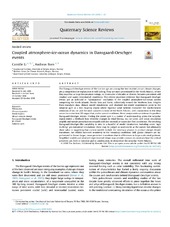| dc.description.abstract | The Dansgaard-Oeschger events of the last ice age are among the best studied abrupt climate changes, yet a comprehensive explanation is still lacking. They are most pronounced in the North Atlantic, where they manifest as large temperature swings, on timescales of decades or shorter, between persistent cold (stadial) and warm (interstadial) conditions. This review examines evidence that Dansgaard-Oeschger events are an unforced or “spontaneous” oscillation of the coupled atmosphere-ice-ocean system comprising the North Atlantic, Nordic Seas and Arctic, collectively termed the Northern Seas. Insights from reanalysis data, climate model simulations, and idealized box model experiments point to the subpolar gyre as a key coupling region where vigorous wind systems encounter the southernmost extension of sea ice and the most variable currents of the North Atlantic, with connections to the deep ocean via convection. We argue that, under special conditions, these components can interact to produce Dansgaard-Oeschger events. Finding the sweet spot is a matter of understanding when the subpolar region enters a feedback loop whereby changes in wind forcing, sea ice cover, and ocean circulation amplify and sustain perturbations towards cold (ice-covered) or warm (ice-free) conditions. The resulting Dansgaard-Oeschger-like variability is seen in a handful of model simulations, including some “ugly duckling” pre-industrial simulations: these may be judged as undesirable at the outset, but ultimately show value in suggesting that current models include the necessary physics to produce abrupt climate transitions, but exhibit incorrect sensitivity to the boundary conditions. Still, glacial climates are hypothesized to favour larger, more persistent transitions due to differences in large-scale wind patterns. Simplified models and idealized experimental setups may provide a means to constrain how the critical processes act, both in isolation and in combination, to destabilize the subpolar North Atlantic. | en_US |

